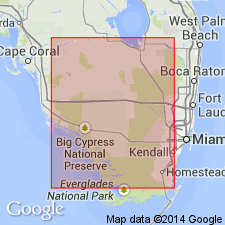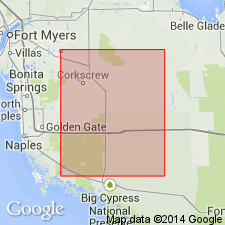
- Usage in publication:
-
- Glades Group, Formation
- Modifications:
-
- Named
- Dominant lithology:
-
- Limestone
- Dolomite
- Anhydrite
- AAPG geologic province:
-
- South Florida province
Summary:
Named Glades Group of the Marquesas Supergroup or Glades Formation of the Marquesas Supergroup for Glades Co., FL. Consists of interbedded brown limestone, dolostone, and anhydrite. Unit is 570 meters thick and includes the Punta Gorda anhydrite. The Glades overlies the Fort Pierce Formation and underlies the Ocean Reef Group (Marquesas Supergroup). Unit is of Early Cretaceous age.
Source: GNU records (USGS DDS-6; Reston GNULEX).

- Usage in publication:
-
- Glades Group*
- Modifications:
-
- Revised
- AAPG geologic province:
-
- South Florida province
Summary:
Glades Group. The Glade is revised to include the Lehigh Acres Formation and its West Felda Shale, Twelve Mile, and Able Members (all new), and the Punta Gorda Anhydrite [this revision accepted for use in USGS reports]. In the type well, the top of the Glades Group remains unchanged (at the top of the Punta Gorda Anhydrite); the base is placed at the top of the Pumpkin Bay Formation (new) at 11,860 feet. Age is Early Cretaceous (Comanchean).
Source: Modified from GNU records (USGS DDS-6; Reston GNULEX).
For more information, please contact Nancy Stamm, Geologic Names Committee Secretary.
Asterisk (*) indicates published by U.S. Geological Survey authors.
"No current usage" (†) implies that a name has been abandoned or has fallen into disuse. Former usage and, if known, replacement name given in parentheses ( ).
Slash (/) indicates name conflicts with nomenclatural guidelines (CSN, 1933; ACSN, 1961, 1970; NACSN, 1983, 2005, 2021). May be explained within brackets ([ ]).

